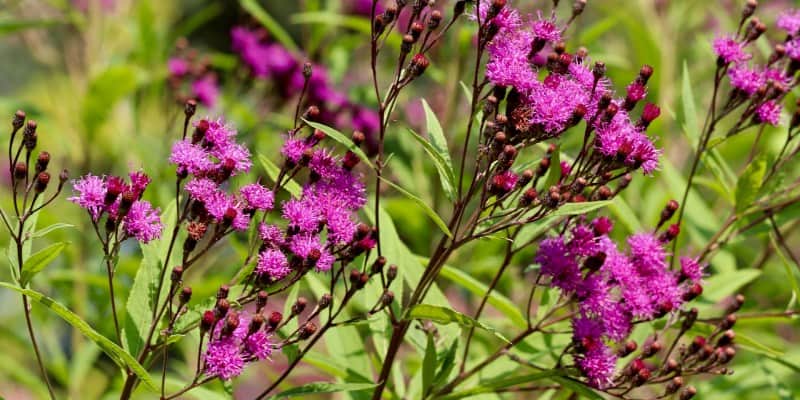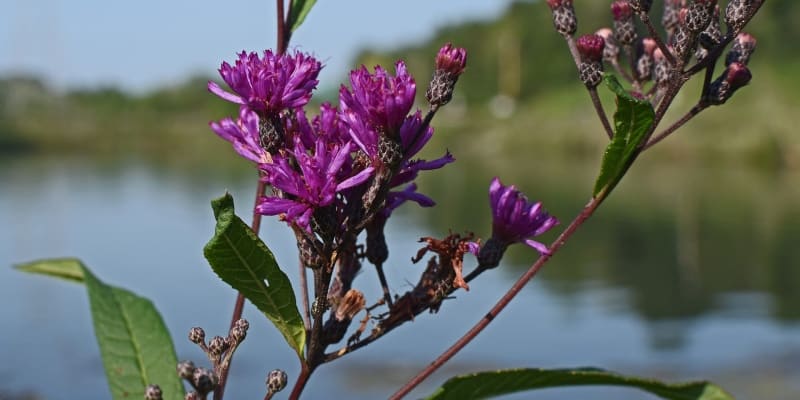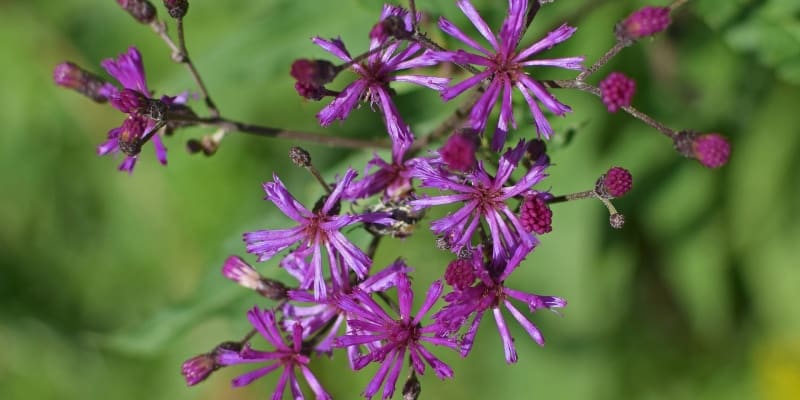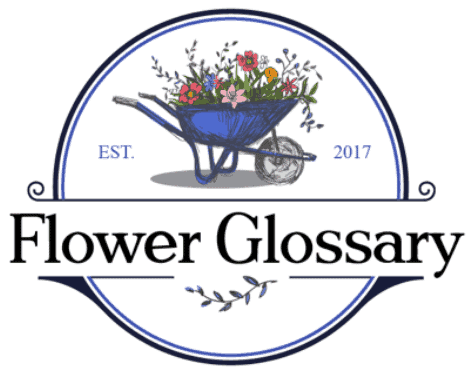Flower Glossary is reader-supported. When you buy through links on our site, we may earn an affiliate commission.
With about 350 recorded species of shrubs and forbs, the Vernonia genus is part of the Asteraceae family. You may recognize some of its various species as ‘ironweed’ with its intense purple flowers. Some Vernonia species are edible, and they can have economic value.
From Vernonia calvoana in Africa to Vernonia nonoensis in South America, these species are known for hybridizing between similar species in overlapping areas. Vernonia can also be found in North America and Southeast Asia.

Table of Contents
Vernonia Overview
Vernonia, or ironweed, is a beautiful and easy-to-grow sun perennial. They provide gorgeous summer colors, attracting hummingbirds and butterflies wherever they are planted. An incredibly tough plant, this species is heat and humidity tolerant. It can grow in dry or lean soils, producing striking clusters of purple flowers in the late summer seasons.
Like other members of the daisy family, ironweed flowers actually consist of multiple small florets. Vernonia produce small fruits with ‘pappus’ hairs that help them blow in the wind to distribute seeds. These fluffy little fruits can germinate very quickly if you sow them immediately – meaning that these plants can also spread quite aggressively in the right conditions.
Vernonia cultivars, bred for garden-use, have stronger stems and flop less as they grow and mature. Featuring airy purple flowers, these plants look best in drifts and along the back of the garden with mixed flowering perennials.
This species is fond of damp locations, and you can usually spot them growing along small bodies of water or along the banks of marshes. Although, certain varieties of this species are also quite drought-tolerant.
Standing tall, with quite a stiff upright habit, Vernonia features tooth-shaped leaves and small bunches of purple flowers. These characteristics make them ideal cut flowers. More rare species of Vernonia feature beautiful white flowers that turn a rust-color with age. This might be where these plants got the name ‘ironweed.’
Herbivores, like deer, generally avoid ironweed, which is known for its slightly bitter taste. This makes it ideal for growing in just about any green, open space.

Different Species of Vernonia
Vernonia is a genus with hundreds of species that feature colorful blooms and attractive foliage. You can find them across the world in North America, South America, Africa, and Southeast Asia. These species include but are not limited to the following:
- Vernonia arborea
- Vernonia arkansana
- Vernonia baldwinii
- Vernonia calvoana
- Vernonia colorata
- Vernonia elaeagnifolia
- Vernonia galamensis
- Vernonia gigantea
- Vernonia missurica
- Vernonia nonoensis
There are a wide variety of other species indigenous to the various continents.
Uses of Vernonia
There are a number of species of Vernonia that people eat as leaf vegetables. These include Vernonia calvoana, Vernonia amygdalina, and Vernonia colorata. Some common names for these leafy greens are ‘onugbu,’ in the Igbo language, or ‘Bitterleaf.’
These species are common in Central and West African countries. Today, they are one of the most commonly consumed leaves in Nigeria and are also the key ingredient to a traditional dish in Cameroon – Ndolé.
In East Africa, people use Vernonia galamensis as an oilseed as it grows in many parts of Ethiopia and has a high oil content. These Ethiopian variants contain up to 40% oil and up to 80% of vernolic acid. This is useful for producing industrial chemicals and products such as adhesives, varnishes, coatings, plasticizers, and paint.
Certain species, such as Vernonia amygdalina (Bitterleaf), is used in traditional herbal medicine. People use leaf decoctions to treat fevers, malaria, diarrhea, hepatitis, and regular coughs. Bitterleaf leaves are used to treat scabies, stomach-aches, and headaches, while root extracts help with gastrointestinal problems.

How To Grow Ironweed
Vernonia can easily grow into a tree, but in reality, it mostly takes the shape of a hedge or shrub. Once planted in your garden, you can pick the leaves and young shoots for anywhere up to seven years. Commercially, however, farmers tend to prefer younger plants.
If you would like to grow some beautiful Vernonia plants to add some color to your garden, there are a few key things to keep in mind.
Climate
Vernonia is a very adaptable and resilient plant species. Areas with 20 inches of annual rainfall are ideal, as Vernonia require rainfall levels that allow for secondary heads to develop on the plant. It’s best to directly sow them into soil in the late fall.
Once you find the perfect spot for your common ironweeds, simply provide some mulch and organic compost in the springtime and water them regularly.
Soil and Ecology
You should try to use porous and well-drained soil to successfully grow these plants. Poorly drained soils will result in either the entire plant dying before it flowers or the top of the plant dying.
While you can use any type of soil to grow Vernonia, humus-rich soils are preferable and will result in better growth. Ironweeds prefer medium to more moist soil; thus, it is necessary to adapt their watering needs from average to high. The wetter the soil, the taller your ironweed will grow.
Vernonia commonly grows naturally alongside lakes and rivers as well as in woodlands or forest margins. They also need full sunlight to grow successfully.
Harvesting
During rainier seasons, harvesting occurs by cutting the leafy shoots, thereby allowing new shoots to grow. The highest yields occur during the rainy season. These can be harvested a couple of weeks later. During drier periods, it is best to only pick the leaves, keeping the shoots intact.
Vernonia In A Nutshell
For centuries, Vernonia has possessed antiseptic properties resulting in its wide use for medicinal purposes. From traditional medicines to Cameroonian soup, this species has a wide variety of uses.
They also make excellent garden plants and cut flowers due to their resilient nature, tough stems, and colorful blooms. Vernonia can grow perfectly well in average garden soil and can make a beautiful background border for your garden.
With striking purple flowers, ironweeds are dynamic and versatile. Just remember, their seeds can spread very quickly, so smaller spaces might soon become overcrowded with these hardy plants!
